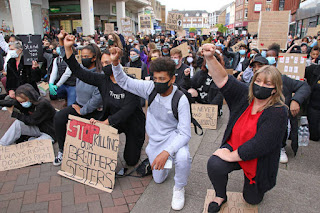Civil Rights Movement 1954 - 1968
Born in the deep south chafing under Jim Crow laws
1954 – Brown vs Board of Education (desegregating schools)
1955 – Emmet Till murder and rosa parks bus boycott (lasts a
full year and changes legislation/desegregates public transportation)
1963 – Birmingham protests, Church bombing, March on Washington
1964 – Civil Rights Act
1965 – Selma march
1967 – Loving vs Virginia
1968 – MLK assassinated
Black Panther Party 1966 - 1982
Product of the children of the great migration who came to adulthood in inner city environments of major metropolitan areas like Oakland/San Franciso, Detroit, Chicago, New York
The Black Panther Party was formed in response to the
killing of an unarmed Black teen by police.
On September 27, 1966, a police officer shot Matthew Johnson, an unarmed 16-year-old, in the back in San Francisco's Hunters Point neighborhood, sparking violent unrest for several days. Huey Newton decided the only way to address police brutality was to monitor the authorities. He read up on California's open-carry laws and, within weeks, had armed men patrolling the streets of Oakland. If they saw an arrest, they would approach with their firearms visible and inform the suspects of their rights. The practice came to be known as "copwatching."
California repealed its open-carry law because of the
Panthers.
According to Stanley Nelson, director of "The Black Panthers: Vanguard of the Revolution," Huey Newton and Bobby Seale chose the Panthers' look because "it was something that everybody had in their closet." The uniform was also calculated to be distinct from the suit-and-tie look favored more traditional civil-rights activists.
The BPP's belief in Black self-determination fueled dozens
of social programs benefiting tens of thousands, including free-breakfast
programs and no-cost medical clinics.
The Party opened "liberation schools,"
where children learned Black history and political science. They practiced
penmanship by writing letters to incarcerated members.
The Brown Berets 1966 - Present
The Chicano movement started in the Southwest, particularly California. It spread through Texas, New Mexico, Colorado, New York, Florida, Chicago, St. Louis and other metropolitan areas with large "raza" populations. As the Brown Berets took shape, they allied heavily with the Black Panthers.
The Brown Berets (Los Boinas Cafés) are a pro-Chicano organization that emerged during the Chicano Movement in the late 1960s co-founded by David Sanchez and Carlos Montes, and remains active to the present day. The group was seen as part of the Third World Liberation Front. The Brown Berets' movements largely revolved around farmworkers' struggles, educational reform, and opposition to the Vietnam War; they have also organized against police brutality. The Brown Berets have also sought to separate the American Southwest from the control of the U.S. government.
During the Chicano movement of the 1960s, murals became key forms of expression for Mexican Americans seeking to tell the stories of their culture and the struggles of daily life brought on by social and economic inequalities. Today, the mural movement is regarded as a continuation of the artistic tradition established by influential Mexican artists such as Diego Rivera, José Clemente Orozco, and David Alfaro Siqueiros.
Art Assignment: Album Covers inspired by Protest Posters






























































